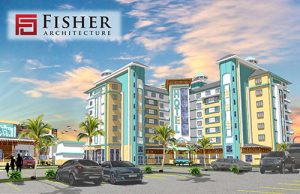
OCEAN CITY — A vast hotel and restaurant complex on the Cropper concrete plant property just north of the Route 50 Bridge moved closer to becoming a reality this week after the Mayor and Council approved a zoning change to accommodate the project.
On Monday, the Mayor and Council approved a zoning change for the historic concrete plant site just north of the Route 50 Bridge to accommodate a proposed eight-and-a-half story hotel and restaurant complex on the property. Ocean I Hospitality LLC, which is now the lead developer on the project, requested the zoning change from the existing M-1 manufacturing zone to Inlet-1, or I-1, a fairly unique zoning designation reserved for a handful of properties along the downtown waterfront.
The project’s conceptual plan, reviewed and approved by the Planning Commission before a favorable recommendation to the Mayor and Council, calls for a mixed-use facility including a restaurant and other recreational amenities along with an eight-and-a-half story hotel situated on the northwest corner of the roughly four-acre parcel. Under the strictest interpretation of the zoning designation, a 12-story hotel could be built on the property.
In addition, a five-story hotel complex could be built on the site, but a project designed as a five-story hotel would sprawl across nearly the entire parcel and right up to the required setbacks, moving the hotel and restaurant closer to the existing neighborhood. As currently proposed, the eight-and-half story hotel is a tradeoff of sorts for the vast amount of open space preserved in the conceptual plan and the significant buffers from the neighboring properties.
From the beginning, the project as proposed has not been without its detractors. During the Planning Commission review of the requested zoning change and the concept plan, several neighbors complained about the size and scope of the proposed project. Two weeks ago, former Councilman Vince Gisriel made a passionate plea to reconsider the zoning change ordinance on first reading and Gisriel returned to council chambers on Monday to renew his last-ditch effort.
“Not to beat a dead horse, but this passage will forever change the character of that area, change the landscape and change the skyline and I hope you reconsider your vote from two years ago and reject this ordinance,” he said. “I have to try one more time to attempt to get you to reject his ordinance. While it may meet some of the design standards, it doesn’t meet all of them.”
Ocean City Development Corporation (OCDC) Executive Director Glenn Irwin said the OCDC did support the project.
“It’s a much larger parcel,” he said. “This happens to be the biggest vacant parcels in the downtown area if not the biggest. That got us thinking the height here would be appropriate because the project overall blends in with what we’re proposing. That area of downtown is going through some renovation and it’s just a really interesting part of town to look at.”
After Gisriel’s dissertation on spot zoning, attorney Joe Moore, who represents the developer, insisted the rezoning of the parcels to Inlet-1 did not meet the definition of the often controversial planning practice.
“This is not spot zoning,” he said. “Spot zoning is defined as zoning that is not for the public benefit, but purely for private benefit and is inconsistent with the surrounding zoning. Traditional spot zoning is when you put an automobile repair and filling station in the middle of a residential area.”
Gisriel also cited sections of Ocean City’s current comprehensive plan in an attempt to point out inconsistencies with the project as proposed. However, Moore countered the project was consistent with the comprehensive plan’s ideals for that section of the downtown area.
“The uses in the concept plan, which we are going to be obligated to put forth, are totally consistent with a restaurant and hotel,” he said. “The eight-and-a-half stories create the open space consistent with the downtown plan. The design standards are consistent with OCDC standards and we are totally consistent with the comprehensive plan.”
After considerable debate, the council voted 6-1, with Councilwoman Mary Knight opposed, to approve the proposed zoning code amendment. The next step will be a site plan review before the Planning Commission.

